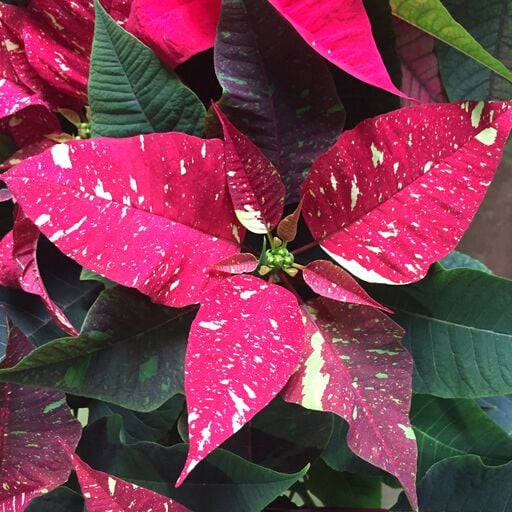
December 12th is National Poinsettia Day, officially recognized in 2002 as a celebration of the holiday season’s most iconic plant, and honoring two men who played a major role in bringing us the festive plant we know today.
The first is Dr. Joel Roberts Poinsett, as December 12th marks the anniversary of his death in 1851. He was the US ambassador to Mexico in the 19th century, and as a keen botanist, he spotted poinsettia plants growing wild, and sent specimens back home to Charleston, South Carolina. There he shared them with fellow plant enthusiasts, and as they were noted to develop red bracts around Christmas time, Bartram’s nursery in Philadelphia started to sell them as holiday plants. At the same time, plantsman Robert Buist introduced the plant to Europe by sending specimens over to his native Scotland. Initially, the plant was known just by its botanical name, Euphorbia pulcherrima, but before long it became commonly known as poinsettia, after Dr. Poinsett.
The second person who played a major role in popularizing poinsettias is Paul Ecke Jr. who took his father’s vision of producing and selling a Christmas flower to new heights. In the early 1920s, seeing how his family’s dairy and orchard business was struggling with growing competition, Paul Ecke Sr. looked for a new product to develop and market. He found it in the form of the poinsettias he saw growing wild in southern California and started his business by growing them for cut flowers for the holiday season.
As cut flowers they did not last very long, and nor could they be easily shipped, so Mr. Ecke hit upon making them a potted plant, thus giving him a potentially much larger market. This involved changing aspects of the wild plant, which by nature is a leggy shrub, with relatively small bracts. Having moved the business from its original location in Hollywood to Encinitas due to the rapidly expanding film industry, he was well placed to start a plant breeding program. He invested in grafting technology, which enabled him to start changing the characteristics of the plant, making it sturdier and bushier, and also producing larger, longer-lasting bracts. New colors were also developed, although to this day red remains by far the most popular color. This breeding program was enhanced by Paul Ecke Jr, and by the 1960s, the family had a competition-beating, secret grafting technique.
With more robust plants that were suited to people’s homes, the popularity of these holiday plants began to spread. However, the family didn’t just rely on word of mouth to expand the business. Paul Ecke Jr. would donate plants to magazines for holiday photoshoots, as well as giving them to television shows over the holidays, thus creating demand for the plants among the general public. By 1986, poinsettias were the top selling potted plant in the US.
With time the business expanded into the wholesale trade, and a large part of the business was generated in creating stock plants for other nurseries to grow on and bring to market. The cost effectiveness of airfreight in the second half of the twentieth century also aided this growth, and the company moved from field grown plants to greenhouse production.
The company’s secret grafting technique served it well, however, shortly after Paul Ecke III took over the business in the 1990s, a graduate student from Minnesota published a paper on a grafting technique, which by coincidence turned out to be what the Ecke family had been doing for many years. It took a few years for competitors to perfect this technique, but it meant that the Ecke family had to look for other ways to maintain a competitive edge. Production was moved to Guatemala, with research and development remaining in California. The company remained successful but ultimately, Paul Ecke III came to the reluctant decision to sell the business as there was no interest among the next generation to go into the family business, and so in 2012 the company was sold to Dutch plant producer, Agribio Group. At that point in time the company commanded 70% of the market share in the US, and 50% worldwide. The following year Agribio merged with German plant group Dümmen, and the Ecke company is now one of the poinsettia producers under Dümmen.
While the Ecke family is no longer involved in the business, it is a testament to their passion for poinsettias that a weedy shrub was to become the most popular potted plant in the US. Thanks to the botanical curiosity of Dr. Poinsett and the business acumen of the Ecke family, more than 34 million plants are sold each year, accounting for around 53% of the winter holiday plant sales. There are now over 100 varieties, although red will always be the color of Christmas and the winter holidays, making December 12th the perfect time of year to recognize this plant and the people who made it such a favorite.
By Catherine Cooper
Sources:
https://marketsize.net/poinsettias/
https://pss.uvm.edu/ppp/articles/points.htm
https://nationaldaycalendar.com/national-poinsettia-day-december-12/
https://pss.uvm.edu/ppp/articles/poinhist.html
https://www.ambius.com/blog/the-long-strange-tale-of-the-poinsettia-in-christmas-lore/









